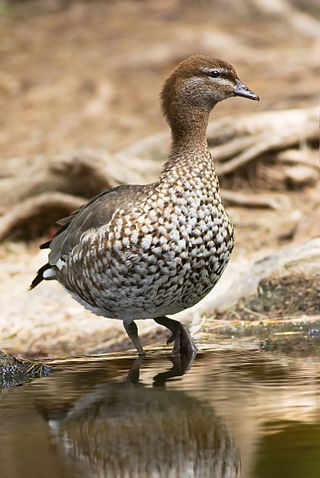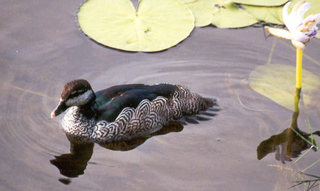
Duck is the common name for numerous species of waterfowl in the family Anatidae. Ducks are generally smaller and shorter-necked than swans and geese, which are members of the same family. Divided among several subfamilies, they are a form taxon; they do not represent a monophyletic group, since swans and geese are not considered ducks. Ducks are mostly aquatic birds, and may be found in both fresh water and sea water.

The Anatidae are the biological family of water birds that includes ducks, geese, and swans. The family has a cosmopolitan distribution, occurring on all the world's continents except Antarctica. These birds are adapted for swimming, floating on the water surface, and in some cases diving in at least shallow water. The family contains around 174 species in 43 genera.

Anseriformes is an order of birds also known as waterfowl that comprises about 180 living species of birds in three families: Anhimidae, Anseranatidae, and Anatidae, the largest family, which includes over 170 species of waterfowl, among them the ducks, geese, and swans. Most modern species in the order are highly adapted for an aquatic existence at the water surface. With the exception of screamers, males have penises, a trait that has been lost in the Neoaves. Due to their aquatic nature, most species are web-footed.

The Oxyurini are a tribe of the duck subfamily of birds, the Anatinae. It has been subject of considerable debate about its validity and circumscription. Some taxonomic authorities place the group in its own subfamily, the Oxyurinae. Most of its members have long, stiff tail feathers which are erected when the bird is at rest, and relatively large, swollen bills. Though their relationships are still enigmatic, they appear to be closer to swans and true geese than to the typical ducks. The highest diversity is found in the warmer parts of the Americas, but at least one species occurs in a major part of the world.

The diving ducks, commonly called pochards or scaups, are a category of duck which feed by diving beneath the surface of the water. They are part of Anatidae, the diverse and very large family that includes ducks, geese, and swans.

The Anatinae are a subfamily of the family Anatidae. Its surviving members are the dabbling ducks, which feed mainly at the surface rather than by diving. The other members of the Anatinae are the extinct moa-nalo, a young but highly apomorphic lineage derived from the dabbling ducks.
The term perching ducks is used colloquially to mean any species of ducks distinguished by their readiness to perch high in trees

The shelducks, most species of which are found in the genus Tadorna, are a group of large birds in the Tadorninae subfamily of the Anatidae, the biological family that includes the ducks and most duck-like waterfowl such as the geese and swans.

The knob-billed duck, or African comb duck, is a type of duck found along the tropical/sub-tropical wetlands and waterways of Sub-Saharan Africa and the island of Madagascar, as well as most of South Asia and mainland Indochina.

The comb duck or American comb duck, is an unusual duck, found in tropical wetlands in continental South America south to the Paraguay River region in eastern Paraguay, southeastern Brazil and extreme northeastern Argentina, and as a vagrant on Trinidad.

Anas is a genus of dabbling ducks. It includes the pintails, most teals, and the mallard and its close relatives. It formerly included additional species but following the publication of a molecular phylogenetic study in 2009 the genus was split into four separate genera. The genus now contains 31 living species. The name Anas is the Latin for "duck".

Alopochen is a genus of the bird family Anatidae, part of the subfamily Tadorninae along with the shelducks. It contains one extant species, the Egyptian goose, and two or three species which became extinct in the last 1,000 years or so. The Egyptian goose is native to mainland Africa, and the extinct species are from Madagascar and the Mascarene Islands.

Aix is a bird genus that contains two species of ducks: the wood duck, and the Mandarin duck. Aix is an Ancient Greek word used by Aristotle to refer to an unknown diving bird.

The Australian wood duck, maned duck or maned goose is a dabbling duck found throughout much of Australia. It is the only living species in the genus Chenonetta. Traditionally placed in the subfamily Anatinae, it might belong to the subfamily Tadorninae (shelducks); the ringed teal may be its closest living relative.

The pygmy geese are a group of very small "perching ducks" in the genus Nettapus which breed in the Old World tropics. They are the smallest of all wildfowl. As the "perching ducks" are a paraphyletic group, they need to be placed elsewhere. The initially assumed relationship with the dabbling duck subfamily Anatinae has been questioned, and it appears they form a lineage in an ancient Gondwanan radiation of waterfowl, within which they are of unclear affinities. An undescribed fossil species from the late Hemphillian of Jalisco, central Mexico, has also been identified from the distal end of a tarsometatarsus. It is only record of the genus in the New World.

The torrent duck is a member of the duck, goose and swan family Anatidae. It is the only member of the genus Merganetta. It is placed in the shelduck subfamily Tadorninae after the "perching duck" assemblage to which it was formerly assigned was dissolved because it turned out to be paraphyletic.

The steamer ducks are a genus (Tachyeres) of ducks in the family Anatidae. All of the four species occur at the southern cone of South America in Chile and Argentina, and all except the flying steamer duck are flightless; even this one species capable of flight rarely takes to the air. They can be aggressive and are capable of chasing off predators like petrels. Bloody battles of steamer ducks with each other over territory disputes are observed in nature. They even kill waterbirds that are several times their size.

Hartlaub's duck is a dark chestnut-coloured duck of African forests. Formerly included in the paraphyletic "perching duck" assemblage, it was later moved to the dabbling duck assemblage. However, it is fairly distinct from the "typical" dabbling ducks, and is placed in the monotypic genus Pteronetta to reflect this.
Bradley Curtis Livezey was an American ornithologist with scores of publications. His main research included the evolution of flightless birds, the systematics of birds, and the ecology and behaviour of steamer ducks.
















